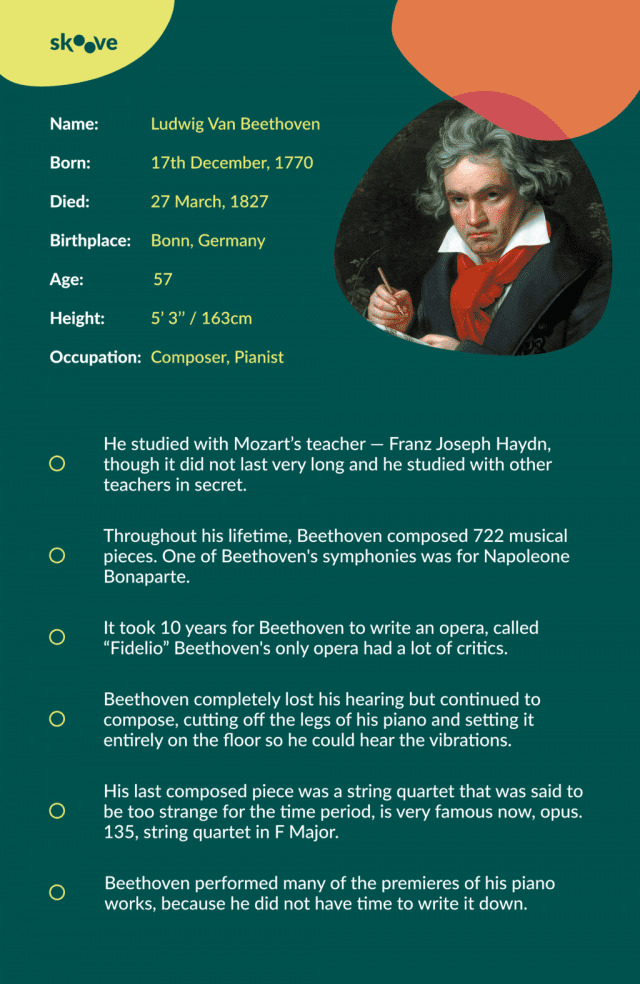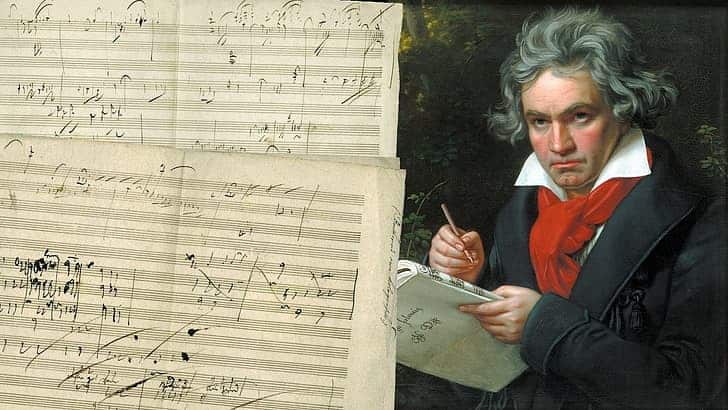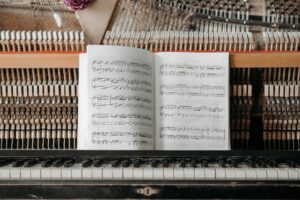Few composers in the history of western music have achieved the same level of fame and musical honors as Ludwig van Beethoven. Beethoven’s music is so ubiquitous that he finds himself as a member of the “3 B’s of Classical Music”, Bach, Beethoven, and Brahms.
Ludwig van Beethoven composed for a wide range of instruments and ensembles including:
- The piano
- The violin
- Symphony orchestra
- String quartet
However, Beethoven did not need an orchestra to move his audience. He was just as effective composing for the piano, whether it be the piano concerto, the piano sonata, or single pieces for the instrument. He was a true icon of the western classical world, and one of the undisputed figureheads of piano composition.
Below, we help you explore how to play Beethoven on the piano. We also explore some of the basic information about the composer himself.

The most famous Beethoven songs
Beethoven’s most famous pieces were not written during his early compositional period, but later on in his life. This is true for many composers as they mature and improve. However, Beethoven faced a challenge of ever-worsening hearing problems.
The famous works that we think of associated with Moonlight Sonata, The Emperor Piano Concerto, Eroica Symphony, Ode to Joy, Für Elise, Pathetique Sonata, Violin Concerto in D Major, Violin Sonata No. 9, The Fifth Symphony, and the Ninth Symphony.
Of course, there are wonderful hidden works of his that some musicians love more than others, but the works mentioned above are among his most critically important. These are some of the best piano songs not only of Beethoven, but of any composer throughout history.
Für Elise
Für Elise is a piece written for solo piano, but it is not one of the piano sonatas. Legend has it, the song was initially intended as a love song for one person, but her name was not Elise, it was Therese, a lazy editor mistakenly wrote the name as “Elise” and it stuck. The song was not actually published until long after Beethoven’s death.
Skoove’s lesson for Für Elise is written in a 3/4 time signature, and the key signature is A minor. Our course onhow to play piano includes a lesson explaining the tricky left-handed fingering, and the correct fingering for the arpeggios and melodies in both right and left hands.
Für Elise also takes advantage of Skoove’s new Full Sheet View, allowing you to look at the entire piece from beginning to end on one page, so you can play and practice all at your own pace.
Additionally, the classical piano sheet music is marked with dynamics, pedal markings for the damper pedal, and complete fingerings, which are where you should put your right and left hand in every position you play the piano.
Ode to Joy
Ode to Joy is not a specific song written in its own right, but a movement written inside of Beethoven’s Symphony No. 9, often subtitled The Choral Symphony. The lyrics to the ode were originally written by Friedrich Schiller, and the music by Beethoven, providing the final movement of his 9th symphony.
The tune was adopted as the Anthem of Europe in 1972, and the subsequent adoption by the European Union. It is difficult to imagine a higher honor for a piece written by a composer in the 1820s, than its continued life in the 21st century. Beethoven’s writing is so powerful and beautiful that it can be adapted easily to many other instruments for any other occasion.
Skoove’s lesson onOde to Joy shows the song is in a 4/4 time signature, adapted in the key of C major (it was originally written in D major). It makes up part of the Beginners Piano Music Collection. The bass line contains long tones, which are commonly referred to as bell tones, imitating the noble and peaceful tolling of bells, with long durations. This helps to make it one of the simplest famous Beethoven songs.
Moonlight Sonata
Moonlight Sonata is the first movement of Beethoven’s Piano Sonata No. 14, written in 1801. It is synonymous with Beethoven’s beautiful and tragic-sounding piano compositions, which often flipped between being incredibly powerful to being sincere, quiet, and contemplative.
Moonlight Sonata was originally written in C# minor but is played in our lesson in D minor, and counted in 12/8. This is one of the iconic Beethoven piano sonatas and the simple arpeggios are relatively simple in D minor. The right hand playing provides the majority of the challenge for new players.
To play the piece in the somber mood intended, the sustain pedal can be held for longer, drawn out sections. For beginners, don’t get hung up on the pedals, and take care to learn the notes first.
Appassionata Sonata
Beethoven’s Appassionata Sonata (Sonata No. 23 in F minor, Op. 57) is considered one of his most technically demanding and emotionally intense compositions. The name “Appassionata” means “passionate,” and the piece truly embodies Beethoven’s fiery temperament. The first movement begins with a dark and mysterious theme, gradually building into powerful climaxes. The final movement is especially thrilling, featuring rapid octaves and stormy passages.
Waldstein Sonata
The Waldstein Sonata (Sonata No. 21 in C major, Op. 53) is a brilliant and energetic work, often considered a turning point in Beethoven’s piano style. Known for its rapid arpeggios, vibrant themes, and dazzling finale, this piece showcases Beethoven’s transition into the Romantic era. The sonata was dedicated to Count Ferdinand von Waldstein, a patron and supporter of Beethoven.
Beethoven’s Turkish March
Beethoven’s Turkish March, also known as Marcia alla turca, comes from his incidental music “The Ruins of Athens” (Op. 113). This lively and rhythmic piece imitates the marching style of Turkish military bands, a popular trend in classical music at the time. The light, bouncy texture and catchy melody make it an enjoyable piece for pianists of all levels.
Beethoven’s most famous symphonies
- Symphony No. 5
- Symphony No. 3, “Eroica”
- Symphony No. 6, “Pastoral”
- Symphony No. 7
- Symphony No. 8
- Symphony No. 9, “Choral”
What is the most famous symphony composed by Beethoven? Many consider Symphony No. 5 to be his most iconic work, instantly recognizable by its powerful four-note opening motif. However, Beethoven composed nine symphonies, each bringing something unique to classical music. While Symphony No. 5 and No. 9 (“Choral”) are the most widely recognized, other symphonies like the lyrical “Pastoral” Symphony No. 6, the energetic Symphony No. 7, and the playful Symphony No. 8 also hold a special place in musical history. A symphony is an elaborate musical composition, typically written with four movements. Often a symphony will include different combinations of instruments depending on how the song was written, and the period it was written in. It can incorporate a combination of strings, horns, woodwinds, and percussion. This can also include a piano but it is not a prerequisite.
Symphony No. 5
This symphony was written between the years 1804 and 1808 and is perhaps the most well-known symphony or even piece of classical music that has ever been written. Beethoven takes a very simple refrain and transforms it into an iconic and serious piece of music, that is unmistakable to any musician as Beethoven’s Symphony No. 5.
Skoove has taken Beethoven’s 5th symphony and translated it from an entire symphonic work of dozens of instruments to a beautiful piece that is approachable by any beginner. Written in the time signature of 4/4 the piece at first sounds simple, but it does have some challenges. The piece is much more rhythmically complex than it seems at first because the melody does not start on the first beat of each measure.
Symphony No. 3, “Eroica”
Symphony No. 3 is one of the pieces that made Beethoven take his place among the “3 B’s of Classical Music”. A traditional-sounding melody, simply stated, spreads between multiple instruments and strings until finally builds to a form of crescendo.
This piece has been used many times in films, advertisements, and theater. It is more of a cultural phenomenon than a lot of other classical music, because of the way that the music has been arranged by Beethoven and the dynamics of the piece.
Symphony No. 6, “Pastoral”
Beethoven’s Symphony No. 6 in F major, Op. 68, commonly known as the “Pastoral Symphony”, is unique among his symphonies for its programmatic elements, meaning it paints vivid musical pictures of nature. Each movement depicts scenes like a flowing brook, a thunderstorm, and a shepherd’s song, making it one of Beethoven’s most serene and descriptive compositions.
Symphony No. 7
Symphony No. 7 in A major, Op. 92 is one of Beethoven’s most rhythmically driven and exuberant symphonies. The second movement (Allegretto) is particularly famous—it has been featured in numerous films and performances as a standalone piece due to its hypnotic and emotional depth. Richard Wagner famously called this symphony “the apotheosis of dance”, highlighting its infectious energy and pulsing rhythm.
Symphony No. 8
Though often overshadowed by Symphony No. 7 and No. 9, Symphony No. 8 in F major, Op. 93 is a delightful and playful work. Unlike some of Beethoven’s more dramatic symphonies, this piece is lively, humorous, and compact, with moments of surprising syncopation and rhythmic quirks. Some scholars believe it reflects Beethoven’s admiration for Haydn’s witty musical style.
Symphony No. 9, “Choral”
The Symphony No. 9, “Choral” is the symphony where the Ode To Joy is found, and is known as a revolutionary piece, as it includes lyrics set to the music, something not common at the time. Ode To Joy does not actually occur until the final movement of this four movement symphony, which typically takes around an hour to play. The last movement is what makes this symphony most famous, but the whole symphony is stunning and intense.
Originally written in the key of D minor, it was Beethoven’s Opus. 125, and is the final symphony completed by Ludwig van Beethoven, composed between 1822 and 1824. Beethoven’s 9th symphony piano is one of the most frequently performed symphonies in the world, and in 2011 the original hand-written manuscript of the score was added to the Memory of the World Programme Heritage List as part of the United Nations and is the first musical score to be added to the collection. This is one of Beethoven’s most famous pieces.
Beethoven’s most famous piano concertos
Beethoven’s famous songs come in a lot of different types. A piano concerto is different from a piano sonata because a concerto is usually made up of three movements. The sonata is typically a single-instrument performance, or one played by a small ensemble.
Piano Concerto No. 5
- Beethoven’s 5th piano concerto was written in the key of E-Flat Major and composed in 1809.
- Beethoven’s “Emperor Concerto”, was dedicated to Archduke Rolf.
- It premiered on November 28, 1811, in a concert hall in Leipzig.
- The piece was meant to stylize the heroic aspects of the military and the music typical in a military-style band.
The piece was a favorite of fellow pianist and composer Franz Liszt who frequently performed the concerto throughout his life and career as a performer. It was also described by famous and prolific musicologist Alfred Einstein as “the apotheosis of the military concept”, invoking the imagery of an emperor, or historic battle. This led to it taking on a sobriquet or nickname and becoming known simply as “Emperor”.
Piano Concerto No. 4
- Beethoven’s Piano Concerto No. 4 publicly premiered in 1808 having been played privately in 1807 at the home of Franz Joseph von Lobokowitz.
- Beethoven dedicated the concerto to his friend and student Archduke Rudolph.
- When it premiered Beethoven played piano, taking the stage as the soloist.
In the modern day, this piece is frequently recorded and is a favorite of the concert-goers. It is considered by many critics and listeners alike to be one of the pinnacles of the piano concerto repertoire, which is not surprising considering the emotional weight and complexity of the work.
Piano Concerto No. 3
Generally thought to have been composed in the year 1800 in the key of C minor, Beethoven’s Piano Concerto No. 3 was first performed in April of 1803, with Beethoven himself performing the part of the solo pianist accompanied by the orchestra. His friend Ignaz von Seyfried turned the pages for him during the performance and famously spoke on the night of Beethoven’s incredible piano playing and skill:
“I saw almost nothing but empty pages; at the most, on one page or another a few Egyptian hieroglyphs wholly unintelligible to me were scribbled down to serve as clues for him; for he played nearly all the solo part from memory since, as was so often the case, he had not had time to set it all down on paper.”
Piano Concerto No. 2
Although labeled as Piano Concerto No. 2 in B-flat major, Op. 19, this concerto was actually composed before his first published concerto. It has a lighter, more Mozart-like character, with a playful and elegant feel. Beethoven wrote this piece in his early years, and while it lacks the grandeur of his later concertos, it still showcases his brilliant keyboard technique and youthful energy.
Piano Concerto No. 1
Beethoven’s Piano Concerto No. 1 in C major, Op. 15 was his first published piano concerto and reflects his early classical influences, particularly those of Mozart and Haydn. While it follows the elegant and structured style of the Classical era, it also hints at Beethoven’s emerging boldness and originality, which would define his later works. The piece features bright and playful themes, contrasted with moments of dramatic intensity, showcasing Beethoven’s developing command over the concerto form.
Beethoven’s early career as a composer
Born to Johann Beethoven and Maria Magdalena Keverich in the city of Bonn, Germany, Beethoven was early to start playing piano, and music was within his family. His first music teacher was his father, but eventually he moved onto more advanced teachers such as:
- the court organist Gilles van den Eeden
- Tobias Pfeiffer
- Franz Anton Ries, who taught him the violin
Beethoven’s early composing career began in 1783 at 13 with a set of keyboard compositions, when he was working as an assistant organist of the court chapel. From 1785-1790 there is almost no record of his early composition career.
Ludwig met the famous composer Joseph Haydn in late 1790, who would become his teacher for a brief, productive period, but they quickly grew apart due to Haydn’s composing workload and Beethoven even studied secretly behind Haydn’s back in an attempt not to offend the master composer of instrumental music.
Quick facts about Beethoven
Here are some quick and interesting facts about Beethoven:
- Beethoven composed 32 piano sonatas, shaping the future of piano music.
- Beethoven is said to have been unlucky in love, and this was the inspiration for much of his writing.
- He is the third “Ludwig van Beethoven” in his family.
- Beethoven began to lose his hearing as young as 26.
- Despite his deafness, Beethoven continued to compose some of his greatest works, including symphonies, piano sonatas, and string quartets.
- He is known for his innovative and emotionally powerful compositions that bridged the Classical and Romantic eras.
- Beethoven’s most famous works include the Ninth Symphony, the Moonlight Sonata, and the Fifth Symphony.
- He was known for his fiery temperament and uncompromising dedication to his artistic vision.

Author of this blog post

Published by Lydia Hovan from the Skoove team















